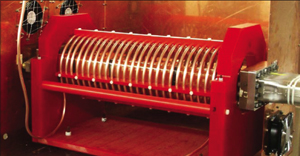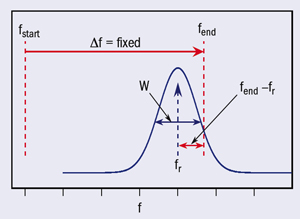The SPIN@COSY polarized-beam team has found striking new results while studying the spin-manipulation of polarized deuterons at the Cooler Synchrotron (COSY) at the Forschungszentrum in Jülich. The team – from Michigan, COSY, Bonn, the Japan Proton Accelerator Research Complex (J-PARC), Indiana and Groningen, led by Michigan’s Alan Krisch – used a new RF-solenoid magnet to manipulate the spins of stored 1.85 GeV/c deuterons (spin-1 bosons).

Image credit: Hans Stockhorst/Forschungszentrum, Jülich.
Maria Leonova, a graduate student at Michigan, and Alexander Schnase, an electrical engineer at J-PARC, designed the new RF-solenoid, which was built by Dieter Prasuhn and his accelerator team at COSY. It used the same sophisticated RF high-voltage supply as its predecessor, an RF-dipole. However, the RF solenoid produces a longitudinal RF magnetic field rather than a radial field.
The goal of the experiment was to test precisely a new analytic matrix formalism developed by Alexander Chao of SLAC, a theoretical member of the SPIN@COSY team (Chao 2005). The Chao formalism is the first generalization of the famed Froissart–Stora formula, which allows the calculation of the beam polarization after passing through a spin resonance (Froissart and Stora 1960). This formula is valid only if the initial beam polarization is measured long before crossing the spin resonance and the final beam polarization long after crossing it. As polarized beam hardware and the understanding of spin dynamics improved, however, polarized beam enthusiasts became eager to learn what happens very near or even inside a spin resonance.

Vasily Morozov at Michigan used the Chao formalism to calculate in detail what might happen in a new type of experiment, where a 1 MHz RF-magnet’s frequency is swept by a fixed range of 400 Hz, while its end-frequency fend steps through many different values near and inside an RF spin resonance (figure 2). The Chao–Morozov calculations predicted that, if the magnet’s resonance strength ε was not high enough to flip the spin fully, then there would be large oscillations in the final polarization. These oscillations seem so sensitive to ε and other parameters, such as the beam’s momentum spread, Δp/p, and the resonance’s central frequency fr, that the oscillations might provide a new way to measure such parameters precisely.

The data from the new experiment showed striking oscillations that agree very well with these calculations (figure 3). The experiment’s data also verified the polarization’s extreme sensitivity to the resonance’s strength, ε, the resonance’s frequency spread, δfΔp, (owing to the beam’s momentum spread, Δp/p), and the resonance’s central frequency fr. Moreover, the data clearly demonstrate that the oscillations’ size increased rapidly as the beam’s momentum spread decreased (Morozov et al. 2007 and 2008).
These new experimental results also confirm the validity of the Chao matrix formalism. It may now be used to understand better the behaviour of the 100–250 GeV polarized protons stored in RHIC at Brookhaven and, perhaps in the future, polarized antiprotons in the Facility for Antiproton and Ion Research at GSI (see FAIR gets the green light at GSI), or polarized protons stored in J-PARC or even in the LHC at CERN.
Further reading
A W Chao 2005 Phys. Rev. ST Accel. Beams 8 104001.
M Froissart and R Stora 1960 Nucl. Instrum. Methods 7 297.
V S Morozov et al. 2007 Phys. Rev. ST Accel. Beams 10 104001.
V S Morozov et al. 2008 Phys. Rev. Letts. 100 054801.





